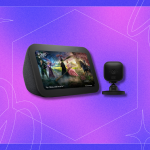This content originally appeared on Mashable for a US audience and has been adapted for the UK audience.
The next generation is here. By which we mean next-gen consoles: the PlayStation 5 and Xbox Series X. They’re pretty much standard for serious gamers going forward. Which means it’s time to also upgrade to a 4K TV. Why miss out on the stunning detail and fast response gameplay that 4K TVs offer?
The PlayStation 5 and Xbox Series X will output gameplay to a 4K TV, so you can see the full glory of 4K-optimised games such as Call of Duty: Modern Warfare II or FIFA 23. You said you wanted an immersive gaming experience? You’ll get it with these perfect pairings.
Most 4K TVs are also loaded with smart features, which are great for when you want to take a break from games, or for when your roommates want to get in some Netflix-and-chill time. Features include support and functionality for streaming media services, voice search, or mirroring content from your phone or tablet.
What is 4K?
4K is a fancy way of saying ultra-high definition. A 4K TV display has at least 8 million active pixels. With a standardised resolution of 3,840 x 2,160, it has four times the resolution of the HD standard of 1080p. Top branded TVs also upscale regular HD and SD content so it looks as polished as possible.
Do you need a 4K TV for gaming?
In a word, yes. At least, you do if you want to get the most about of your next-gen console. The previous gen PS4 Pro and Xbox also support 4K, so you might already be behind the times tech-wise. Not only do the PS5 and Xbox Series X continue with immense 4K content, but the current wave of 4K TVs are packed with other features to meet the consoles’ improved spec. These include eARC (Enhanced Audio Return Channel), ALLM (Auto Low Latency Mode), 4K at 120Hz (High Frame Rate), HGiG tone-mapping, VRR (Variable Refresh Rate), and low input lag.
How big are 4K TVs?
When it comes to 4K, bigger is indeed better. And why not? A bigger screen makes sense when you’re looking to get the most out of the 4K quality — and to set these TVs apart from smartphones and small devices, which we increasingly use to watch HD content. The smallest size in 4K is usually 48 inches, going up to 55, 65, 75, and even 80+ inch screens. Screen size is measured diagonally, from corner to corner.
What is low input lag?
This is tech jargon for how long it takes your TV to turn the data it’s receiving into an actual image on the screen. The lower the input lag (counted in milliseconds) the better. This means the gaming action will be as up-to-speed as possible, without lagging behind what’s happening on the control pad or your opponent’s screen. What good is it if your trigger and target are out of sync? Milliseconds might not sound like something to worry about, but just 100ms can make a huge difference — making games difficult to play, in fact.
What is ALLM?
This stands for Auto Low Latency Mode. It’s a nifty bit of tech which automatically detects a gaming signal and switches your TV to gaming mode. This essentially shuts down any surplus picture processing power, which in turns speeds up the gaming performance and cuts down on the dreaded input. For gamers who like the path of least resistance — i.e. getting into the game with minimal effort — it eliminates the need to switch your TV to its gaming mode before firing up the console.
Do you need HDMI 2.1?
For the PlayStation 5 and Xbox Series X, you absolutely need HDMI 2.1. Both consoles use HDMI 2.1 to output games at up to 120fps (frames per second). HDMI 2.1 is the latest version of HDMI, with a spec that supports an increased bandwidth of 48Gbps. This means higher resolution, faster refresh rates, and better HDR support. HDMI 2.1 also supports eARC, which ensures you’re compatible with the latest audio tech for the best possible sound performance.
While TVs come with multiple HDMI ports, not all ports will be HDMI 2.1 (2.0 is often included as standard — anything under 2.0 won’t be able to handle 4K resolution at anything higher than 30 frames a second). Fortunately, most of the latest crop of 4K TVs will include at least one HDMI 2.1, which is all you need. This is unless you want to have both a PS5 and Xbox Series X plugged in at once. The PS4 and the last Xbox will happily make do with HDMI 2.0 — as will the Nintendo Switch.
What does 120Hz mean?
This is the refresh rate — how many times the screen refreshes per minute. The higher the refresh rate the smoother the handling of motion and gameplay is. With the PS5 and Xbox Series X pumping out games at 120fps, you want a 4K TV that can handle that with 120Hz. Thankfully, most do. You’ll also find some TVs equipped with VRR. This means Variable Refresh Rate, which keeps pace with sudden changes in a game’s fps output to prevent stuttering within gameplay.
What is the best gaming TV?
From high-end options to more wallet-friendly picks, these are the best gaming-friendly 4K TVs that deliver on fast action, quick response, and overall performance.
These are the best 4K TVs for gaming in 2022.







